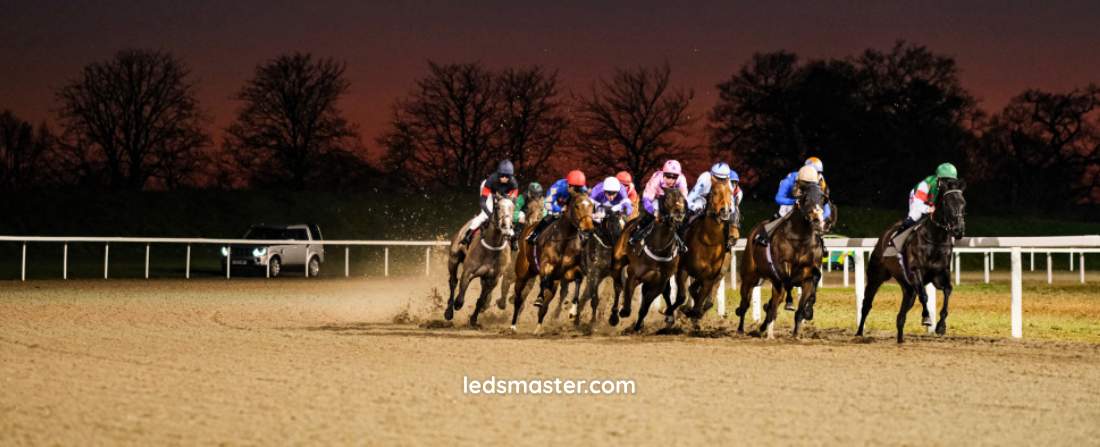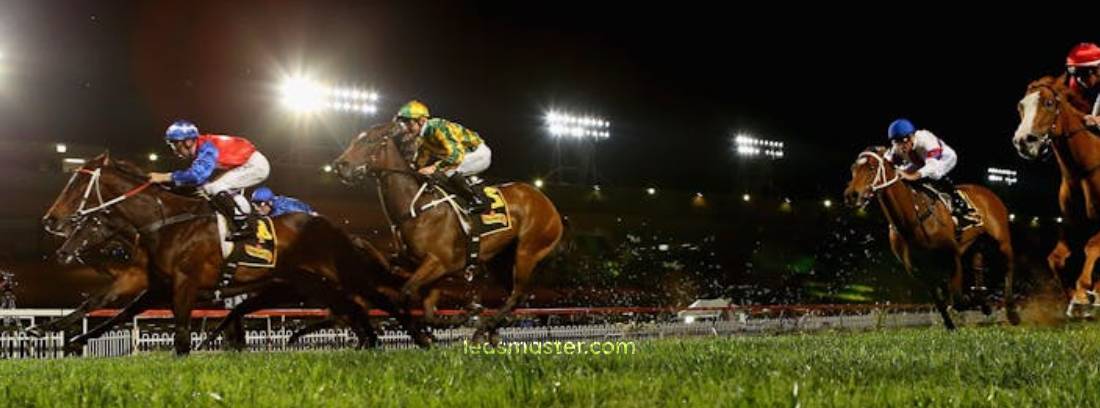Illuminate your horse racing venue with our state-of-the-art racecourse lighting solutions, designed to provide unparalleled visibility and enhance the safety and experience of both participants and spectators. Our high-intensity LED floodlights offer exceptional brightness and uniformity, ensuring every corner of the track is perfectly lit. Elevate your racecourse with reliable, top-quality lighting that meets the highest standards of competition.
Whether it’s a daytime race extending into twilight or a prestigious nighttime event, high-quality racecourse lighting ensures that both spectators and participants have an optimal experience. This article delves into the essential aspects of racecourse lighting design, covering lux requirements, lighting uniformity, color temperature, waterproof and anti-glare features, and tips for selecting the best floodlights, including beam angle and energy efficiency.
Get your complimentary lighting design today
Table of Contents
ToggleIn the realm of racecourse lighting design, lux serves as the fundamental unit of measurement for illuminance, quantifying the amount of light that illuminates a surface per square meter. This measurement plays a pivotal role in ensuring the safety and performance of participants as well as the enjoyment of spectators. The lux requirements for racecourses can differ significantly based on various factors, including the type of events hosted, the size of the track, and the specific needs of participants and broadcasting standards.

For instance, training sessions for horses typically necessitate an average illuminance level of 500 to 1000 lux. This range is adequate for horses and jockeys to navigate the track safely while providing trainers and staff with sufficient visibility to monitor performance and conditions. However, when it comes to professional racing events, the requirements escalate considerably. In such cases, the lux levels should generally fall between 1000 and 1500. This range is designed to ensure that the racecourse is well-illuminated, minimizing any potential hazards associated with poor visibility.
Moreover, the advent of high-definition television broadcasting has introduced even more stringent lighting demands. To capture the action of a race clearly and vividly, the required lux levels often exceed 1500. This high level of illuminance is crucial not only for the safety of participants but also for producing clear, sharp images that enhance the viewing experience for audiences at home and in the stands. Consequently, careful consideration of lux requirements is essential in the planning and design of racecourse lighting systems.
Achieving uniform lighting distribution across the racecourse create a safe and enjoyable environment. Lighting uniformity refers to the evenness of illumination throughout the entire area, and it is crucial for preventing shadows and glare, which can pose risks for both horses and jockeys. Additionally, uneven lighting can detract from the spectator experience, diminishing their enjoyment and engagement with the event.
To quantify lighting uniformity, the uniformity ratio is utilized. This ratio is calculated by dividing the minimum lux level by the average lux level across the track. A recommended uniformity ratio of 0.5 or higher is typically advised for racecourses. This ensures that every section of the track is evenly illuminated, eliminating significant variations in light levels. Achieving such uniformity not only enhances safety but also contributes to a better visual experience for both participants and spectators.
In practical terms, achieving good uniformity may involve strategic placement of lighting fixtures. A well-planned layout that considers the height, angle, and type of light fixtures can significantly improve the overall lighting quality. By avoiding dark spots and overly bright areas, racecourse operators can create a visually appealing and safe environment for everyone involved.
The outdoor environment presents a multitude of challenges for racecourse lighting. Weather conditions can vary greatly, necessitating robust lighting designs capable of withstanding the elements. Waterproof features are particularly important, as they protect lighting fixtures from rain, humidity, and other environmental factors that could compromise their functionality. When selecting lighting fixtures, it is advisable to look for those with an IP65 rating or higher. This rating indicates that the fixtures are dust-tight and protected against water jets from any direction, ensuring their durability and longevity.
In addition to waterproofing, the incorporation of anti-glare features is another critical consideration. Glare can be highly distracting for both horses and jockeys, potentially leading to accidents during races. To combat this issue, modern LED floodlights often come equipped with anti-glare technology. This technology may include specially designed lenses and baffles that help minimize glare while still providing a clear and comfortable viewing experience for spectators.
The benefits of implementing both waterproof and anti-glare features extend beyond safety and performance; they also enhance the overall aesthetic quality of the racecourse. A well-lit venue with minimal glare creates a visually appealing atmosphere that enhances the experience for everyone in attendance.
Color temperature, measured in Kelvin (K), influences the perception of the illuminated area and the overall ambiance of the racecourse. Different color temperatures can evoke distinct feelings and reactions, making it essential to choose an appropriate range for racecourse lighting. For optimal results, a color temperature between 5000K and 6000K is often recommended.
This specific range provides a bright, daylight-like quality that enhances visibility and improves color rendition. Such clarity is essential for both participants and spectators, allowing them to appreciate the details of the race and the vibrant colors of the horses and jockeys’ attire. Conversely, higher color temperatures can appear overly harsh, potentially creating an uncomfortable viewing experience. On the other hand, lower temperatures may result in a yellowish tint that not only diminishes visibility but also detracts from the overall aesthetics of the venue.
Choosing the right color temperature requires consideration of various factors, including the specific characteristics of the racecourse and the type of events being hosted. For instance, evening races may benefit from a slightly warmer color temperature to create a more inviting atmosphere, while daytime events might require cooler temperatures to emulate natural sunlight. By thoughtfully selecting the appropriate color temperature, racecourse operators can enhance both the functionality and aesthetic appeal of their lighting systems.
When it comes to choosing suitable floodlights for a racecourse, several considerations must be taken into account to ensure optimal performance and efficiency. Key factors include beam angle, energy efficiency, heat dissipation, and the overall design and durability of the fixtures. A careful selection process can significantly impact the effectiveness of the lighting system and its long-term sustainability.
The beam angle of a floodlight determine how light is distributed across the area. For racecourses, utilizing a combination of wide and narrow beam angles is often the most effective approach. Wide beam angles, typically around 120 degrees, are suitable for general illumination of large areas. They help ensure that the entire track is sufficiently lit, providing a safe environment for all participants.
Conversely, narrow beam angles ranging from 15 to 45 degrees are particularly effective for highlighting specific sections of the track, such as the finish line or critical turns. This combination of beam angles allows for comprehensive coverage without the presence of dark spots or overly lit areas. By strategically placing floodlights with varying beam angles, racecourse operators can create a well-lit environment that enhances both safety and performance.
LED floodlights have emerged as the preferred choice due to their exceptional energy efficiency, long lifespan, and lower maintenance costs compared to traditional lighting options.
LEDs consume significantly less power while delivering superior brightness and light quality. Their high lumen-per-watt ratio indicates efficient light output for the energy consumed, making them a smart investment for racecourse operators. By opting for energy-efficient lighting solutions, racecourses can reduce their operational costs and minimize their environmental footprint.
In addition to immediate cost savings, the long lifespan of LED floodlights also contributes to their appeal. With proper maintenance, these fixtures can last for many years, reducing the frequency of replacements and the associated costs. By investing in energy-efficient lighting, racecourse operators can create a sustainable lighting system that benefits both their budget and the environment.
Effective heat dissipation is a consideration for maintaining the performance and longevity of LED floodlights. Overheating can not only reduce the lifespan of LEDs but also affect their brightness and overall functionality. As such, quality floodlights are engineered with advanced heat sink technology designed to manage and dissipate heat effectively.
Features such as aluminum fins and thermal management systems are commonly employed to ensure efficient heat dissipation. These designs prevent overheating and contribute to consistent performance over time. By selecting floodlights with superior heat dissipation capabilities, racecourse operators can extend the lifespan of their lighting fixtures and maintain optimal brightness levels.
Racecourse lighting fixtures must be constructed to withstand harsh outdoor conditions, including extreme temperatures, moisture, and physical impacts. As a result, the materials used in manufacturing these fixtures play a significant role in their longevity and reliability. High-quality materials, such as die-cast aluminum and tempered glass, are preferred for their robustness and ability to endure the rigors of outdoor environments.
The design of the fixtures facilitate easy installation and maintenance. Features such as adjustable brackets and modular components can streamline the installation process and allow for quick adjustments when needed. By prioritizing durability and design, racecourse operators can ensure that their lighting systems remain operational and effective over the long term.

The integration of advanced light control and automation features into racecourse lighting systems has become increasingly common in recent years. These systems offer dynamic adjustment capabilities, allowing for changes in light levels based on various factors, including the time of day, specific event requirements, and prevailing weather conditions.
Automated dimming and switching functionalities can optimize energy use, reducing overall consumption while maintaining adequate illumination levels. Such automation not only enhances efficiency but also prolongs the lifespan of lighting fixtures by minimizing unnecessary strain on the system.
Furthermore, integrating control systems allows for remote monitoring and management of the lighting system. Racecourse operators can make real-time adjustments based on changing conditions, ensuring that the lighting operates at peak efficiency throughout each event. This flexibility contributes to a more responsive and adaptive lighting system, enhancing both safety and the overall experience for participants and spectators alike.
The design and implementation of effective lighting systems at racecourses encompass numerous factors that contribute to safety, performance, and the overall experience for participants and spectators. By addressing lux requirements, ensuring lighting uniformity, and incorporating waterproof and anti-glare features, operators can create a well-lit environment that enhances visibility and enjoyment. The thoughtful selection of floodlights, taking into account beam angles, energy efficiency, heat dissipation, and durability, plays a significant role in achieving optimal performance and efficiency.
In addition, the integration of light control and automation features allows racecourses to adapt to changing conditions and event requirements, optimizing energy use and extending the lifespan of lighting fixtures. As the industry continues to evolve, embracing emerging trends such as smart lighting systems and renewable energy sources will be essential for maintaining a competitive edge. By prioritizing quality lighting solutions, racecourse operators can ensure a safe and enjoyable environment that supports the long-term sustainability and success of their venues.